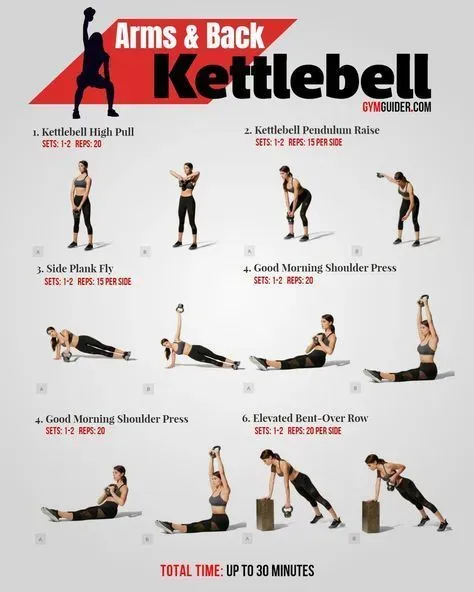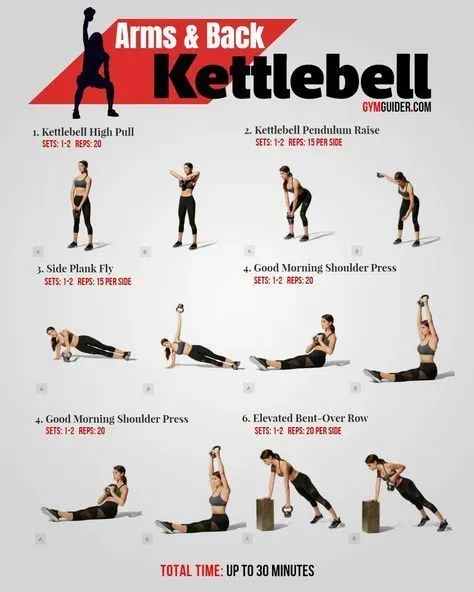Table of Contents
Look, everyone wants strong arms and a back that doesn't ache after carrying groceries. Forget spending hours on fussy machines or needing a gym packed with dumbbells. There’s a simpler, more effective way to build serious upper body power, and it involves one piece of equipment: the kettlebell.
Why Kettlebells Build Strong Arms and Back

Why Kettlebells Build Strong Arms and Back
More Than Just Lifting: The Offset Load Advantage
so why a kettlebell for building those biceps and lats instead of your standard dumbbell? It comes down to how the weight is distributed. A dumbbell's center of mass is usually smack dab in the middle of your hand. Predictable, stable. A kettlebell? Not so much.
The weight hangs below the handle. This offset center of mass means that even simple movements like a bicep curl or a row require more work from your stabilizing muscles. Your forearms have to grip harder, your shoulders and back have to fight to control the swing or the lift. It's not just about moving the weight up and down; it's about managing momentum and resisting forces that want to pull you off balance. This constant adjustment is gold for building dense, functional strength across your arms and back.
Integrated Strength: Working Arms and Back Together
Another reason the kettlebell shines for a kettlebell workout for arms and back is how it encourages compound movements. Think about a kettlebell row. You're not just pulling with your back and biceps; your core has to lock down, your shoulders are engaged for stability, and even your legs are often involved in maintaining a solid base. Contrast that with sitting on a machine row – isolated, yes, but it misses the interconnectedness of your upper body.
Swings, cleans, snatches – these are full-body movements, but they heavily tax the posterior chain, including your lats, traps, and rhomboids, while your arms act as levers and grips. Even overhead presses with a kettlebell challenge your shoulder girdle and upper back differently due to that hanging weight. This integrated approach builds strength that works together, making you genuinely stronger for everyday tasks, not just mirror muscles.
So, what makes the kettlebell so effective for your upper body?
- Offset weight challenges stability
- Engages more stabilizer muscles (forearms, shoulders, core)
- Promotes compound, integrated movements
- Builds functional strength, not just isolation
- Forces you to manage momentum and control
Essential Kettlebell Exercises for Arms and Back

Essential Kettlebell Exercises for Arms and Back
Essential Kettlebell Exercises for Arms and Back
Alright, so you're convinced kettlebells are the real deal for building a solid upper body. Great. But where do you actually start? You don't just grab one and hope for the best. There are specific movements that really hit those arm and back muscles effectively. We're talking about exercises that leverage that unique kettlebell shape and weight distribution to maximum effect. These aren't just isolated curls or extensions; they are compound movements or variations that demand more from your grip, stabilizers, and the synergistic action of your arms and back working together. Mastering a few core lifts is key to building a powerful kettlebell workout for arms and back that actually delivers results.
Crafting Your Kettlebell Workout for Arms and Back

Crafting Your Kettlebell Workout for Arms and Back
Starting Points for Crafting Your Kettlebell Workout for Arms and Back
you've got your kettlebell, you know the basic moves. Now, how do you stitch them together into something that actually builds muscle and strength in your arms and back? First off, figure out your goal. Are you chasing brute strength, muscle size, or just better endurance? This dictates your exercise selection and how you structure things. For a solid kettlebell workout for arms and back, you want a mix. Don't just do endless curls; throw in some heavy rows, overhead presses, and maybe even some carries. Think about hitting the muscles from different angles and with different movement patterns. A single-arm row hits your lats and biceps one way, a strict press torches your shoulders and triceps another. Get a few go-to exercises you can perform safely and effectively.
Structuring Your Sessions for Arms and Back Gains
Once you have your exercises locked down, think about how many sets and reps make sense. Generally, for strength and size, you're looking at fewer reps (say, 5-8) with heavier weight, and multiple sets (3-5). If endurance is the game, lighter weight and higher reps (10-15+) work better. Don't train your arms and back to oblivion every single day. Muscles grow when they recover. Two to three dedicated sessions per week, allowing a day or two of rest in between, is a solid starting point for Crafting Your Kettlebell Workout for Arms and Back. Listen to your body; if something feels off, back down. Progress isn't linear, and pushing through actual pain is just dumb.
What's a common mistake people make when building their first kettlebell routine?
Mastering Form and Avoiding Pitfalls in Your Kettlebell Workout for Arms and Back

Mastering Form and Avoiding Pitfalls in Your Kettlebell Workout for Arms and Back
Why Form Trumps Everything in Your Kettlebell Workout for Arms and Back
Look, swinging a piece of iron around isn't inherently safe if you do it like a maniac. Proper form isn't just some suggestion from a safety pamphlet; it's the difference between building strength and booking an appointment with a physical therapist. Because the weight hangs off-center, a kettlebell exposes faulty movement patterns faster than a bad online date. Your shoulders shouldn't be shrugging up by your ears during a row. Your back shouldn't round like a scared cat during a deadlift variation. Every single rep, whether it's a simple bicep curl or a complex clean and press, demands focus on alignment, tension, and control. Ignoring the basics of posture, bracing your core, and moving from the right joints is asking for trouble. This is especially true when performing a kettlebell workout for arms and back, where the muscles are often connected in complex kinetic chains. Get the form right first, even if it means using a lighter weight than your ego wants.
Common Slip-Ups That Sabotage Your Arms and Back Gains
So you think you've got the basics? Great. But there are still traps waiting. One classic pitfall is letting the kettlebell control you instead of the other way around. During swings or cleans, the weight shouldn't yank your shoulder out of its socket at the top. You need to actively absorb and redirect that force. Another common issue is neglecting proper grip technique. A weak or improper grip not only limits the weight you can lift but also puts unnecessary strain on your wrists and elbows, hindering progress in your kettlebell workout for arms and back. Don't just squeeze for dear life; learn to grip with purpose, engaging your lats and shoulders to create tension up the chain. Finally, stop rushing. Trying to bang out reps faster than you can maintain control is a surefire way to reinforce bad habits and increase injury risk. Slow down, feel the muscles work, and make every repetition count.
What are some red flags that indicate poor form during kettlebell exercises?
- Rounding your lower back during swings or rows
- Shrugging your shoulders towards your ears
- Losing control of the kettlebell's momentum
- Experiencing sharp pain in joints (shoulders, elbows, wrists)
- Using excessive momentum instead of muscle to lift the weight
Your Arms and Back, Forged by Iron
So, there you have it. Ditching the endless sets on isolated machines for a focused kettlebell workout for arms and back isn't just a trend; it's a smart move for building real, functional strength. We've covered the 'why,' the 'what' (those key exercises), and the 'how' (putting a routine together). Remember, consistency trumps complexity. Pick a few key moves, nail the form, and stick with it. You might be surprised how quickly that simple piece of cast iron starts to reshape your upper body and improve how you move in the real world. Now, go pick up that bell.